Globalization, Health, and Media: A Study of the Ebola Virus Outbreak
VerifiedAdded on 2023/06/13
|11
|3129
|277
Essay
AI Summary
This essay explores the impact of globalization on the spread and control of the Ebola virus disease, referencing the Diffusion of Innovation theory by E.M. Rodgers. It highlights how globalization, coupled with the rise of social media, has influenced the communication and management of the Ebola outbreak, particularly in West African countries like Ghana, Liberia, Guinea, and Sierra Leone. The essay examines the varying rates at which different demographics adopt new technologies and information, focusing on the youth's susceptibility to alternative media and its potential impact on public health messaging and moral considerations during a health crisis. It also discusses the challenges of morality in the context of new media and collaborative journalism, where misinformation can easily spread, affecting public perception and response to health emergencies.
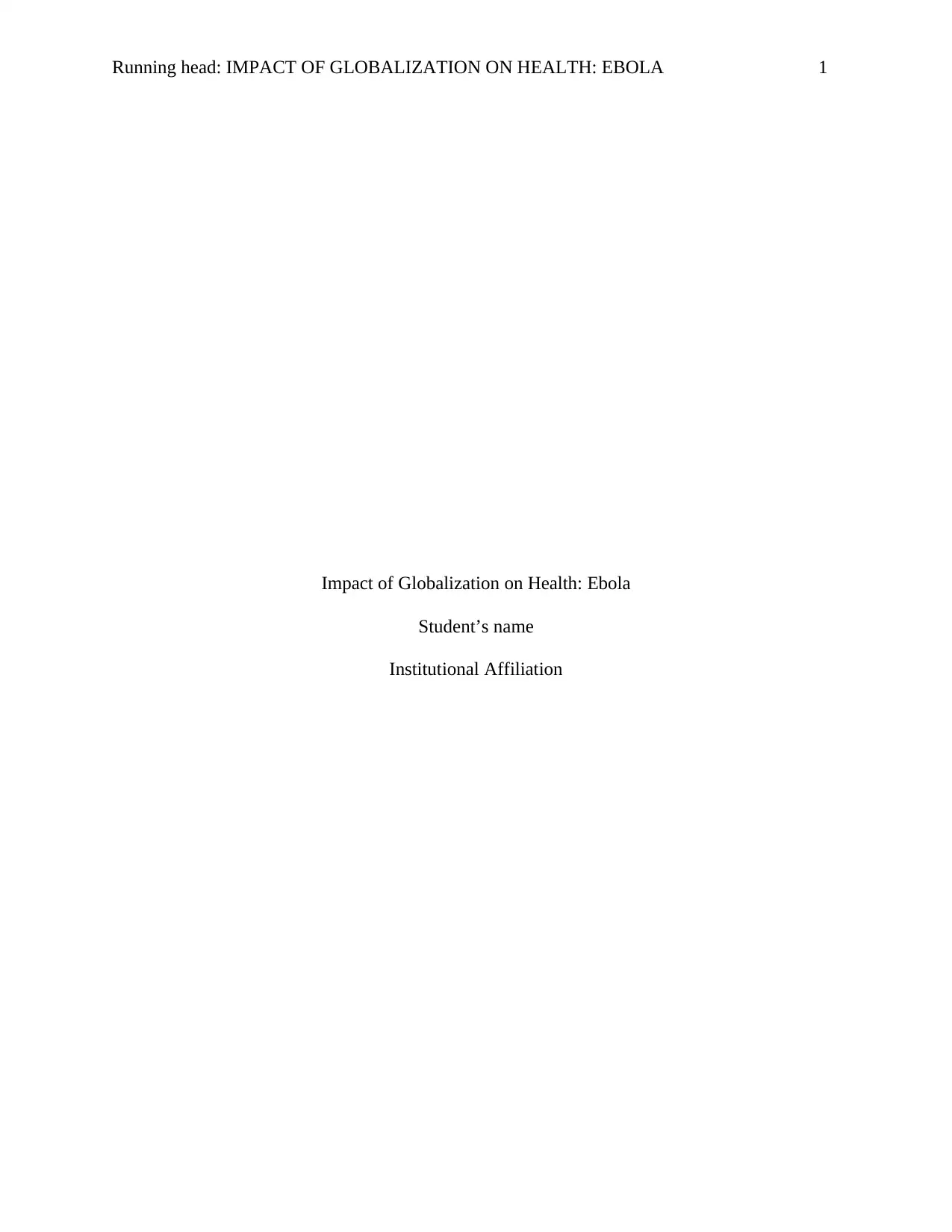
Running head: IMPACT OF GLOBALIZATION ON HEALTH: EBOLA 1
Impact of Globalization on Health: Ebola
Student’s name
Institutional Affiliation
Impact of Globalization on Health: Ebola
Student’s name
Institutional Affiliation
Paraphrase This Document
Need a fresh take? Get an instant paraphrase of this document with our AI Paraphraser
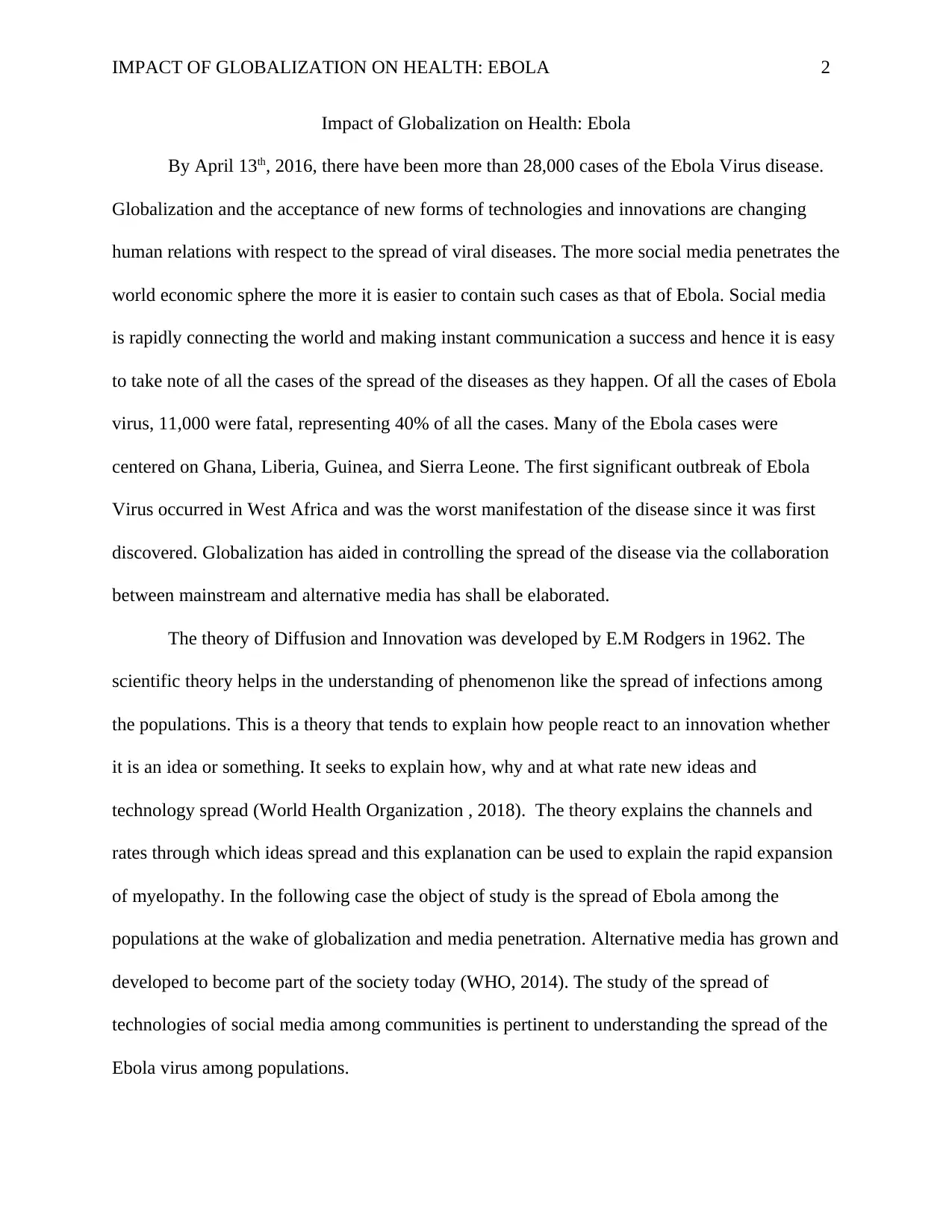
IMPACT OF GLOBALIZATION ON HEALTH: EBOLA 2
Impact of Globalization on Health: Ebola
By April 13th, 2016, there have been more than 28,000 cases of the Ebola Virus disease.
Globalization and the acceptance of new forms of technologies and innovations are changing
human relations with respect to the spread of viral diseases. The more social media penetrates the
world economic sphere the more it is easier to contain such cases as that of Ebola. Social media
is rapidly connecting the world and making instant communication a success and hence it is easy
to take note of all the cases of the spread of the diseases as they happen. Of all the cases of Ebola
virus, 11,000 were fatal, representing 40% of all the cases. Many of the Ebola cases were
centered on Ghana, Liberia, Guinea, and Sierra Leone. The first significant outbreak of Ebola
Virus occurred in West Africa and was the worst manifestation of the disease since it was first
discovered. Globalization has aided in controlling the spread of the disease via the collaboration
between mainstream and alternative media has shall be elaborated.
The theory of Diffusion and Innovation was developed by E.M Rodgers in 1962. The
scientific theory helps in the understanding of phenomenon like the spread of infections among
the populations. This is a theory that tends to explain how people react to an innovation whether
it is an idea or something. It seeks to explain how, why and at what rate new ideas and
technology spread (World Health Organization , 2018). The theory explains the channels and
rates through which ideas spread and this explanation can be used to explain the rapid expansion
of myelopathy. In the following case the object of study is the spread of Ebola among the
populations at the wake of globalization and media penetration. Alternative media has grown and
developed to become part of the society today (WHO, 2014). The study of the spread of
technologies of social media among communities is pertinent to understanding the spread of the
Ebola virus among populations.
Impact of Globalization on Health: Ebola
By April 13th, 2016, there have been more than 28,000 cases of the Ebola Virus disease.
Globalization and the acceptance of new forms of technologies and innovations are changing
human relations with respect to the spread of viral diseases. The more social media penetrates the
world economic sphere the more it is easier to contain such cases as that of Ebola. Social media
is rapidly connecting the world and making instant communication a success and hence it is easy
to take note of all the cases of the spread of the diseases as they happen. Of all the cases of Ebola
virus, 11,000 were fatal, representing 40% of all the cases. Many of the Ebola cases were
centered on Ghana, Liberia, Guinea, and Sierra Leone. The first significant outbreak of Ebola
Virus occurred in West Africa and was the worst manifestation of the disease since it was first
discovered. Globalization has aided in controlling the spread of the disease via the collaboration
between mainstream and alternative media has shall be elaborated.
The theory of Diffusion and Innovation was developed by E.M Rodgers in 1962. The
scientific theory helps in the understanding of phenomenon like the spread of infections among
the populations. This is a theory that tends to explain how people react to an innovation whether
it is an idea or something. It seeks to explain how, why and at what rate new ideas and
technology spread (World Health Organization , 2018). The theory explains the channels and
rates through which ideas spread and this explanation can be used to explain the rapid expansion
of myelopathy. In the following case the object of study is the spread of Ebola among the
populations at the wake of globalization and media penetration. Alternative media has grown and
developed to become part of the society today (WHO, 2014). The study of the spread of
technologies of social media among communities is pertinent to understanding the spread of the
Ebola virus among populations.
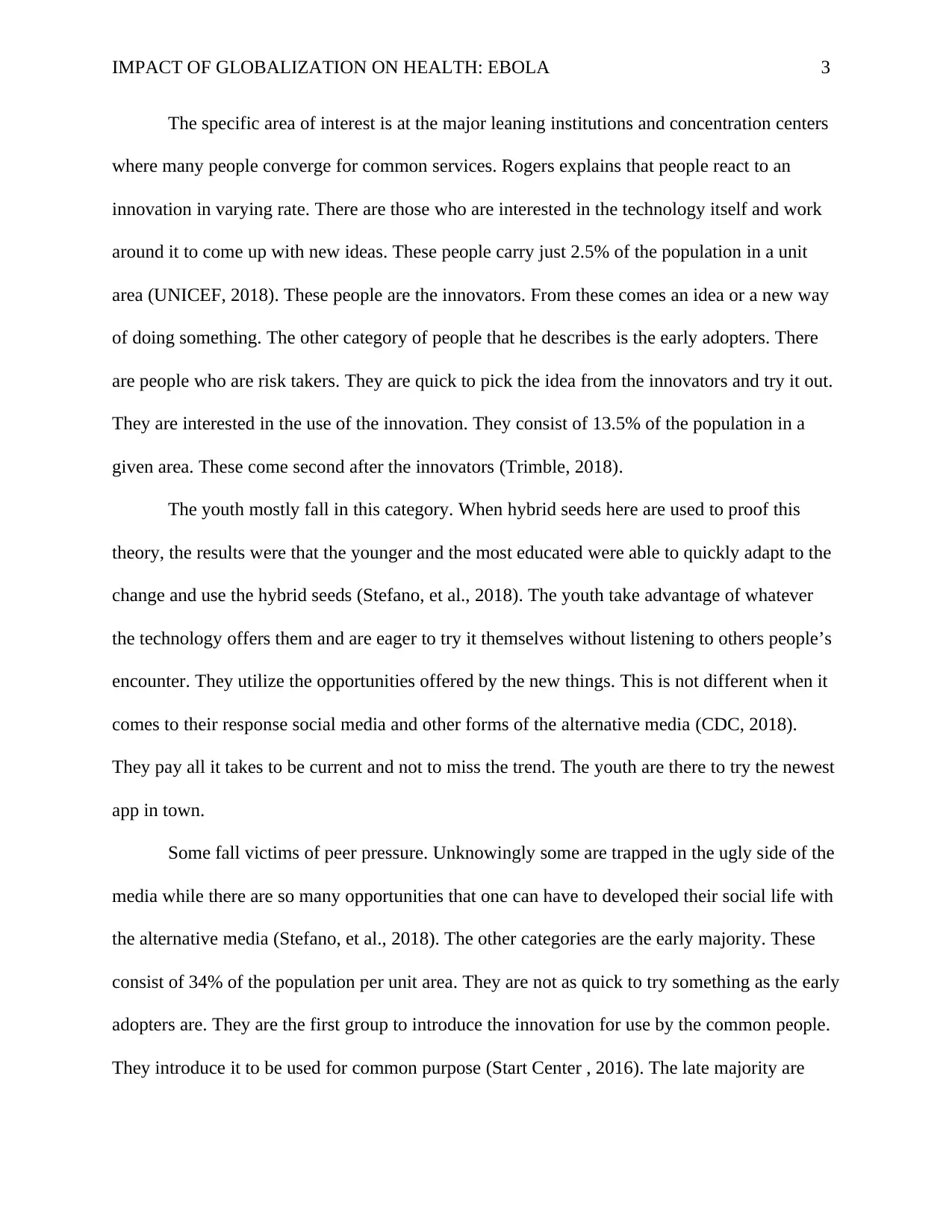
IMPACT OF GLOBALIZATION ON HEALTH: EBOLA 3
The specific area of interest is at the major leaning institutions and concentration centers
where many people converge for common services. Rogers explains that people react to an
innovation in varying rate. There are those who are interested in the technology itself and work
around it to come up with new ideas. These people carry just 2.5% of the population in a unit
area (UNICEF, 2018). These people are the innovators. From these comes an idea or a new way
of doing something. The other category of people that he describes is the early adopters. There
are people who are risk takers. They are quick to pick the idea from the innovators and try it out.
They are interested in the use of the innovation. They consist of 13.5% of the population in a
given area. These come second after the innovators (Trimble, 2018).
The youth mostly fall in this category. When hybrid seeds here are used to proof this
theory, the results were that the younger and the most educated were able to quickly adapt to the
change and use the hybrid seeds (Stefano, et al., 2018). The youth take advantage of whatever
the technology offers them and are eager to try it themselves without listening to others people’s
encounter. They utilize the opportunities offered by the new things. This is not different when it
comes to their response social media and other forms of the alternative media (CDC, 2018).
They pay all it takes to be current and not to miss the trend. The youth are there to try the newest
app in town.
Some fall victims of peer pressure. Unknowingly some are trapped in the ugly side of the
media while there are so many opportunities that one can have to developed their social life with
the alternative media (Stefano, et al., 2018). The other categories are the early majority. These
consist of 34% of the population per unit area. They are not as quick to try something as the early
adopters are. They are the first group to introduce the innovation for use by the common people.
They introduce it to be used for common purpose (Start Center , 2016). The late majority are
The specific area of interest is at the major leaning institutions and concentration centers
where many people converge for common services. Rogers explains that people react to an
innovation in varying rate. There are those who are interested in the technology itself and work
around it to come up with new ideas. These people carry just 2.5% of the population in a unit
area (UNICEF, 2018). These people are the innovators. From these comes an idea or a new way
of doing something. The other category of people that he describes is the early adopters. There
are people who are risk takers. They are quick to pick the idea from the innovators and try it out.
They are interested in the use of the innovation. They consist of 13.5% of the population in a
given area. These come second after the innovators (Trimble, 2018).
The youth mostly fall in this category. When hybrid seeds here are used to proof this
theory, the results were that the younger and the most educated were able to quickly adapt to the
change and use the hybrid seeds (Stefano, et al., 2018). The youth take advantage of whatever
the technology offers them and are eager to try it themselves without listening to others people’s
encounter. They utilize the opportunities offered by the new things. This is not different when it
comes to their response social media and other forms of the alternative media (CDC, 2018).
They pay all it takes to be current and not to miss the trend. The youth are there to try the newest
app in town.
Some fall victims of peer pressure. Unknowingly some are trapped in the ugly side of the
media while there are so many opportunities that one can have to developed their social life with
the alternative media (Stefano, et al., 2018). The other categories are the early majority. These
consist of 34% of the population per unit area. They are not as quick to try something as the early
adopters are. They are the first group to introduce the innovation for use by the common people.
They introduce it to be used for common purpose (Start Center , 2016). The late majority are
⊘ This is a preview!⊘
Do you want full access?
Subscribe today to unlock all pages.

Trusted by 1+ million students worldwide
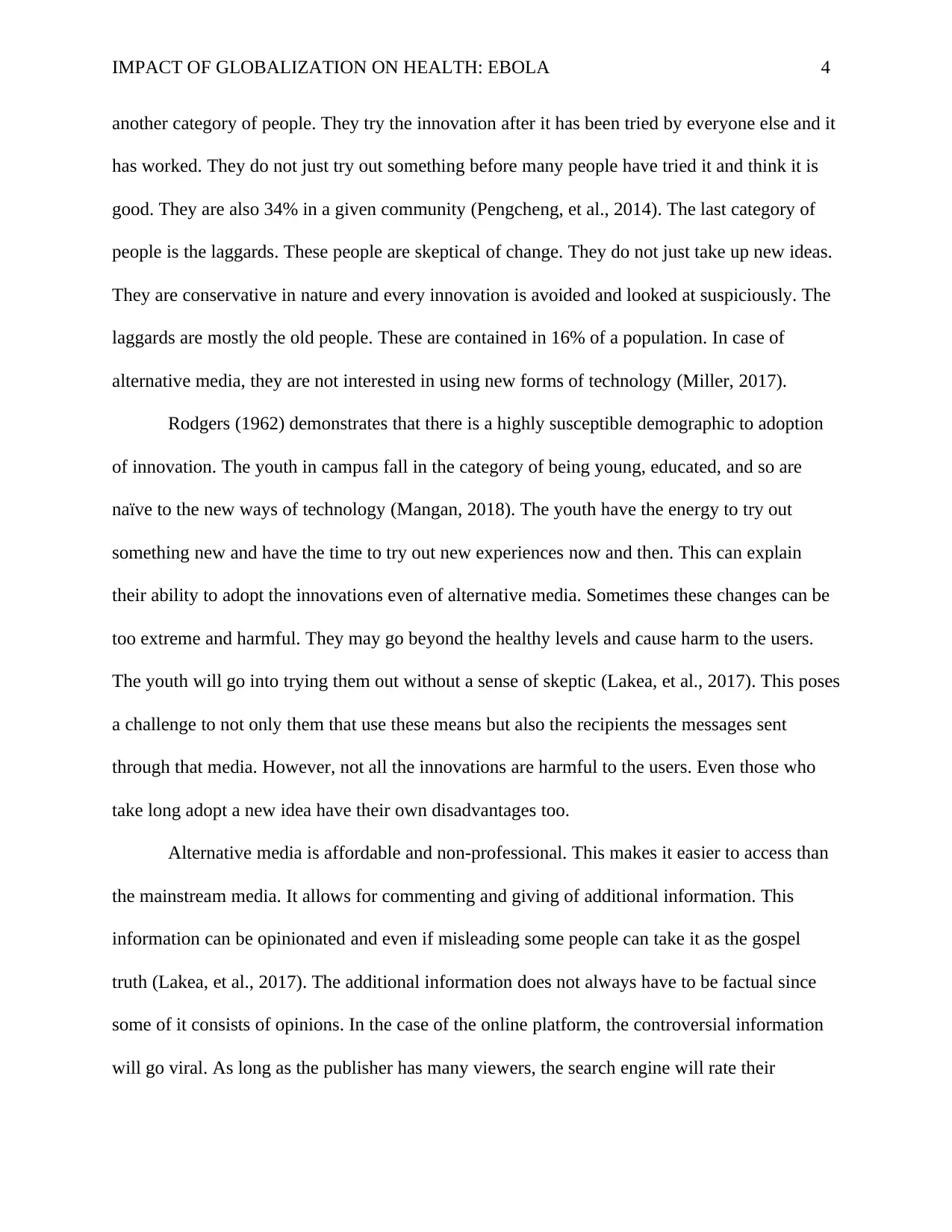
IMPACT OF GLOBALIZATION ON HEALTH: EBOLA 4
another category of people. They try the innovation after it has been tried by everyone else and it
has worked. They do not just try out something before many people have tried it and think it is
good. They are also 34% in a given community (Pengcheng, et al., 2014). The last category of
people is the laggards. These people are skeptical of change. They do not just take up new ideas.
They are conservative in nature and every innovation is avoided and looked at suspiciously. The
laggards are mostly the old people. These are contained in 16% of a population. In case of
alternative media, they are not interested in using new forms of technology (Miller, 2017).
Rodgers (1962) demonstrates that there is a highly susceptible demographic to adoption
of innovation. The youth in campus fall in the category of being young, educated, and so are
naïve to the new ways of technology (Mangan, 2018). The youth have the energy to try out
something new and have the time to try out new experiences now and then. This can explain
their ability to adopt the innovations even of alternative media. Sometimes these changes can be
too extreme and harmful. They may go beyond the healthy levels and cause harm to the users.
The youth will go into trying them out without a sense of skeptic (Lakea, et al., 2017). This poses
a challenge to not only them that use these means but also the recipients the messages sent
through that media. However, not all the innovations are harmful to the users. Even those who
take long adopt a new idea have their own disadvantages too.
Alternative media is affordable and non-professional. This makes it easier to access than
the mainstream media. It allows for commenting and giving of additional information. This
information can be opinionated and even if misleading some people can take it as the gospel
truth (Lakea, et al., 2017). The additional information does not always have to be factual since
some of it consists of opinions. In the case of the online platform, the controversial information
will go viral. As long as the publisher has many viewers, the search engine will rate their
another category of people. They try the innovation after it has been tried by everyone else and it
has worked. They do not just try out something before many people have tried it and think it is
good. They are also 34% in a given community (Pengcheng, et al., 2014). The last category of
people is the laggards. These people are skeptical of change. They do not just take up new ideas.
They are conservative in nature and every innovation is avoided and looked at suspiciously. The
laggards are mostly the old people. These are contained in 16% of a population. In case of
alternative media, they are not interested in using new forms of technology (Miller, 2017).
Rodgers (1962) demonstrates that there is a highly susceptible demographic to adoption
of innovation. The youth in campus fall in the category of being young, educated, and so are
naïve to the new ways of technology (Mangan, 2018). The youth have the energy to try out
something new and have the time to try out new experiences now and then. This can explain
their ability to adopt the innovations even of alternative media. Sometimes these changes can be
too extreme and harmful. They may go beyond the healthy levels and cause harm to the users.
The youth will go into trying them out without a sense of skeptic (Lakea, et al., 2017). This poses
a challenge to not only them that use these means but also the recipients the messages sent
through that media. However, not all the innovations are harmful to the users. Even those who
take long adopt a new idea have their own disadvantages too.
Alternative media is affordable and non-professional. This makes it easier to access than
the mainstream media. It allows for commenting and giving of additional information. This
information can be opinionated and even if misleading some people can take it as the gospel
truth (Lakea, et al., 2017). The additional information does not always have to be factual since
some of it consists of opinions. In the case of the online platform, the controversial information
will go viral. As long as the publisher has many viewers, the search engine will rate their
Paraphrase This Document
Need a fresh take? Get an instant paraphrase of this document with our AI Paraphraser
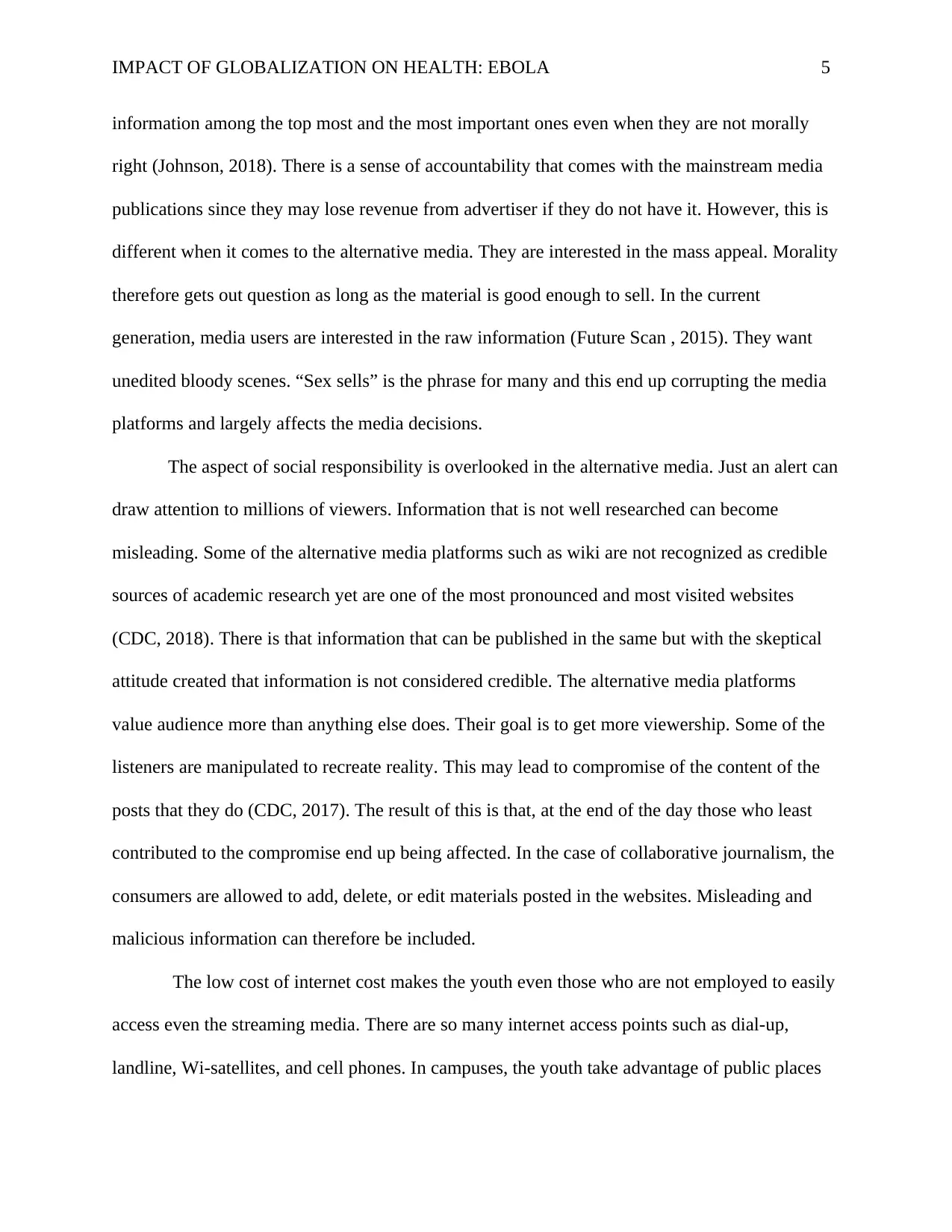
IMPACT OF GLOBALIZATION ON HEALTH: EBOLA 5
information among the top most and the most important ones even when they are not morally
right (Johnson, 2018). There is a sense of accountability that comes with the mainstream media
publications since they may lose revenue from advertiser if they do not have it. However, this is
different when it comes to the alternative media. They are interested in the mass appeal. Morality
therefore gets out question as long as the material is good enough to sell. In the current
generation, media users are interested in the raw information (Future Scan , 2015). They want
unedited bloody scenes. “Sex sells” is the phrase for many and this end up corrupting the media
platforms and largely affects the media decisions.
The aspect of social responsibility is overlooked in the alternative media. Just an alert can
draw attention to millions of viewers. Information that is not well researched can become
misleading. Some of the alternative media platforms such as wiki are not recognized as credible
sources of academic research yet are one of the most pronounced and most visited websites
(CDC, 2018). There is that information that can be published in the same but with the skeptical
attitude created that information is not considered credible. The alternative media platforms
value audience more than anything else does. Their goal is to get more viewership. Some of the
listeners are manipulated to recreate reality. This may lead to compromise of the content of the
posts that they do (CDC, 2017). The result of this is that, at the end of the day those who least
contributed to the compromise end up being affected. In the case of collaborative journalism, the
consumers are allowed to add, delete, or edit materials posted in the websites. Misleading and
malicious information can therefore be included.
The low cost of internet cost makes the youth even those who are not employed to easily
access even the streaming media. There are so many internet access points such as dial-up,
landline, Wi-satellites, and cell phones. In campuses, the youth take advantage of public places
information among the top most and the most important ones even when they are not morally
right (Johnson, 2018). There is a sense of accountability that comes with the mainstream media
publications since they may lose revenue from advertiser if they do not have it. However, this is
different when it comes to the alternative media. They are interested in the mass appeal. Morality
therefore gets out question as long as the material is good enough to sell. In the current
generation, media users are interested in the raw information (Future Scan , 2015). They want
unedited bloody scenes. “Sex sells” is the phrase for many and this end up corrupting the media
platforms and largely affects the media decisions.
The aspect of social responsibility is overlooked in the alternative media. Just an alert can
draw attention to millions of viewers. Information that is not well researched can become
misleading. Some of the alternative media platforms such as wiki are not recognized as credible
sources of academic research yet are one of the most pronounced and most visited websites
(CDC, 2018). There is that information that can be published in the same but with the skeptical
attitude created that information is not considered credible. The alternative media platforms
value audience more than anything else does. Their goal is to get more viewership. Some of the
listeners are manipulated to recreate reality. This may lead to compromise of the content of the
posts that they do (CDC, 2017). The result of this is that, at the end of the day those who least
contributed to the compromise end up being affected. In the case of collaborative journalism, the
consumers are allowed to add, delete, or edit materials posted in the websites. Misleading and
malicious information can therefore be included.
The low cost of internet cost makes the youth even those who are not employed to easily
access even the streaming media. There are so many internet access points such as dial-up,
landline, Wi-satellites, and cell phones. In campuses, the youth take advantage of public places
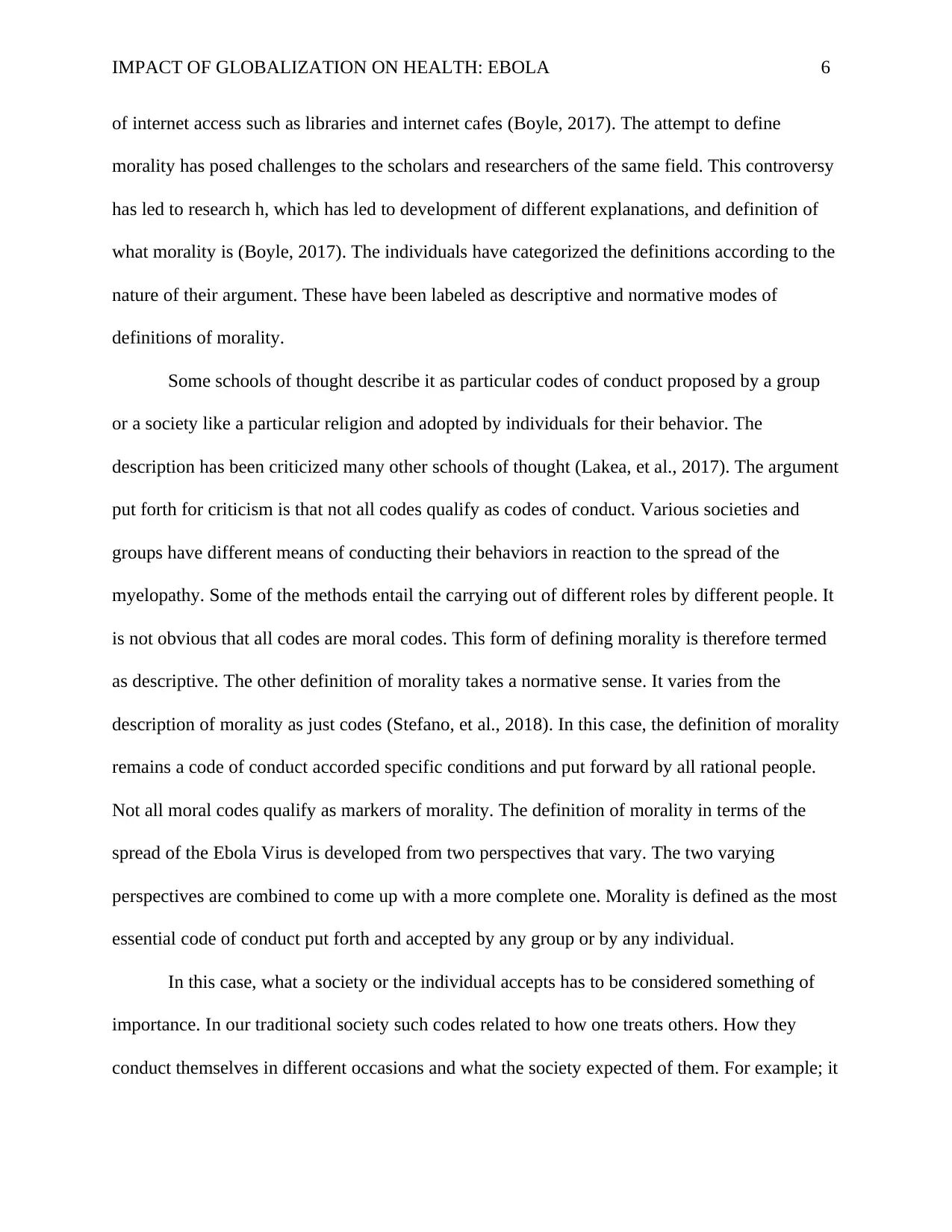
IMPACT OF GLOBALIZATION ON HEALTH: EBOLA 6
of internet access such as libraries and internet cafes (Boyle, 2017). The attempt to define
morality has posed challenges to the scholars and researchers of the same field. This controversy
has led to research h, which has led to development of different explanations, and definition of
what morality is (Boyle, 2017). The individuals have categorized the definitions according to the
nature of their argument. These have been labeled as descriptive and normative modes of
definitions of morality.
Some schools of thought describe it as particular codes of conduct proposed by a group
or a society like a particular religion and adopted by individuals for their behavior. The
description has been criticized many other schools of thought (Lakea, et al., 2017). The argument
put forth for criticism is that not all codes qualify as codes of conduct. Various societies and
groups have different means of conducting their behaviors in reaction to the spread of the
myelopathy. Some of the methods entail the carrying out of different roles by different people. It
is not obvious that all codes are moral codes. This form of defining morality is therefore termed
as descriptive. The other definition of morality takes a normative sense. It varies from the
description of morality as just codes (Stefano, et al., 2018). In this case, the definition of morality
remains a code of conduct accorded specific conditions and put forward by all rational people.
Not all moral codes qualify as markers of morality. The definition of morality in terms of the
spread of the Ebola Virus is developed from two perspectives that vary. The two varying
perspectives are combined to come up with a more complete one. Morality is defined as the most
essential code of conduct put forth and accepted by any group or by any individual.
In this case, what a society or the individual accepts has to be considered something of
importance. In our traditional society such codes related to how one treats others. How they
conduct themselves in different occasions and what the society expected of them. For example; it
of internet access such as libraries and internet cafes (Boyle, 2017). The attempt to define
morality has posed challenges to the scholars and researchers of the same field. This controversy
has led to research h, which has led to development of different explanations, and definition of
what morality is (Boyle, 2017). The individuals have categorized the definitions according to the
nature of their argument. These have been labeled as descriptive and normative modes of
definitions of morality.
Some schools of thought describe it as particular codes of conduct proposed by a group
or a society like a particular religion and adopted by individuals for their behavior. The
description has been criticized many other schools of thought (Lakea, et al., 2017). The argument
put forth for criticism is that not all codes qualify as codes of conduct. Various societies and
groups have different means of conducting their behaviors in reaction to the spread of the
myelopathy. Some of the methods entail the carrying out of different roles by different people. It
is not obvious that all codes are moral codes. This form of defining morality is therefore termed
as descriptive. The other definition of morality takes a normative sense. It varies from the
description of morality as just codes (Stefano, et al., 2018). In this case, the definition of morality
remains a code of conduct accorded specific conditions and put forward by all rational people.
Not all moral codes qualify as markers of morality. The definition of morality in terms of the
spread of the Ebola Virus is developed from two perspectives that vary. The two varying
perspectives are combined to come up with a more complete one. Morality is defined as the most
essential code of conduct put forth and accepted by any group or by any individual.
In this case, what a society or the individual accepts has to be considered something of
importance. In our traditional society such codes related to how one treats others. How they
conduct themselves in different occasions and what the society expected of them. For example; it
⊘ This is a preview!⊘
Do you want full access?
Subscribe today to unlock all pages.

Trusted by 1+ million students worldwide
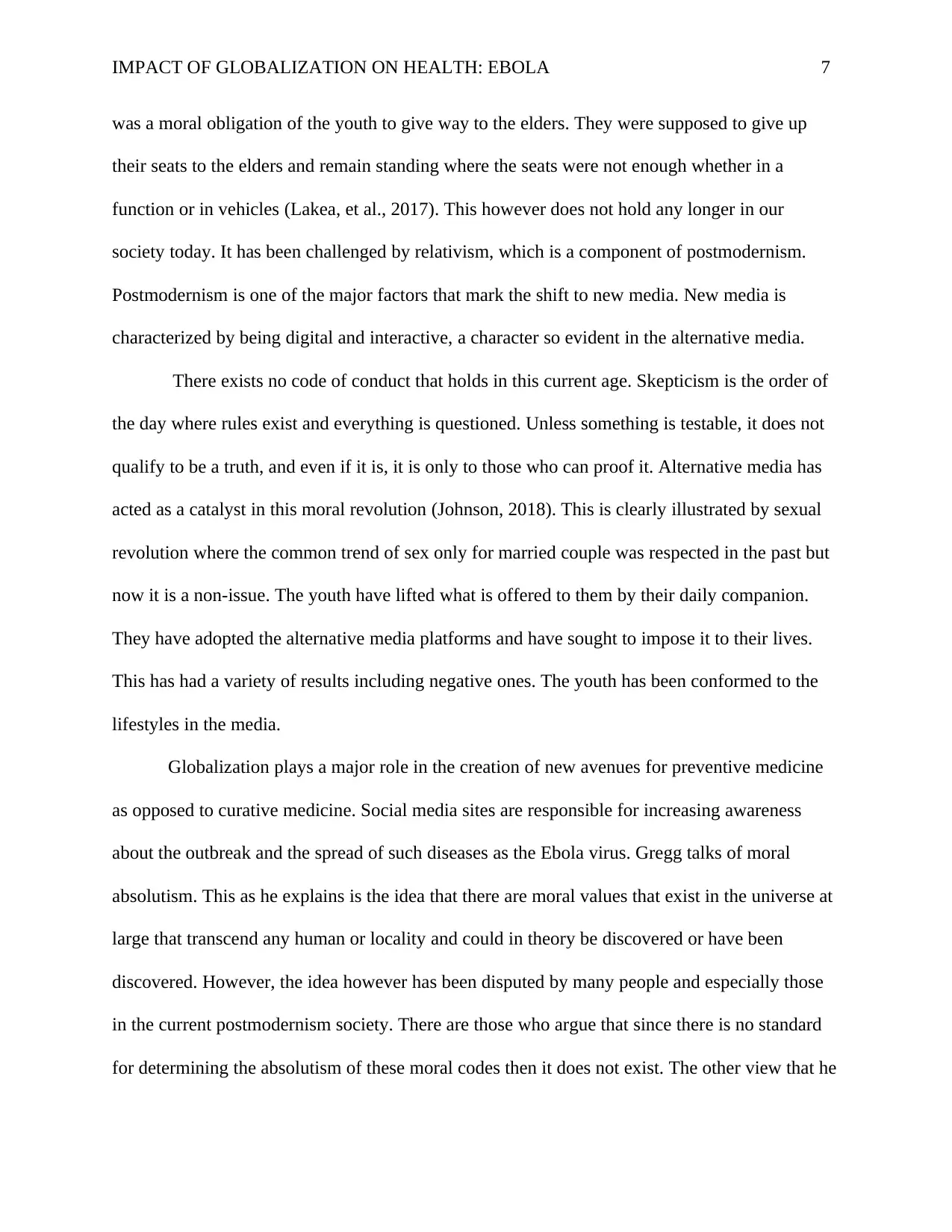
IMPACT OF GLOBALIZATION ON HEALTH: EBOLA 7
was a moral obligation of the youth to give way to the elders. They were supposed to give up
their seats to the elders and remain standing where the seats were not enough whether in a
function or in vehicles (Lakea, et al., 2017). This however does not hold any longer in our
society today. It has been challenged by relativism, which is a component of postmodernism.
Postmodernism is one of the major factors that mark the shift to new media. New media is
characterized by being digital and interactive, a character so evident in the alternative media.
There exists no code of conduct that holds in this current age. Skepticism is the order of
the day where rules exist and everything is questioned. Unless something is testable, it does not
qualify to be a truth, and even if it is, it is only to those who can proof it. Alternative media has
acted as a catalyst in this moral revolution (Johnson, 2018). This is clearly illustrated by sexual
revolution where the common trend of sex only for married couple was respected in the past but
now it is a non-issue. The youth have lifted what is offered to them by their daily companion.
They have adopted the alternative media platforms and have sought to impose it to their lives.
This has had a variety of results including negative ones. The youth has been conformed to the
lifestyles in the media.
Globalization plays a major role in the creation of new avenues for preventive medicine
as opposed to curative medicine. Social media sites are responsible for increasing awareness
about the outbreak and the spread of such diseases as the Ebola virus. Gregg talks of moral
absolutism. This as he explains is the idea that there are moral values that exist in the universe at
large that transcend any human or locality and could in theory be discovered or have been
discovered. However, the idea however has been disputed by many people and especially those
in the current postmodernism society. There are those who argue that since there is no standard
for determining the absolutism of these moral codes then it does not exist. The other view that he
was a moral obligation of the youth to give way to the elders. They were supposed to give up
their seats to the elders and remain standing where the seats were not enough whether in a
function or in vehicles (Lakea, et al., 2017). This however does not hold any longer in our
society today. It has been challenged by relativism, which is a component of postmodernism.
Postmodernism is one of the major factors that mark the shift to new media. New media is
characterized by being digital and interactive, a character so evident in the alternative media.
There exists no code of conduct that holds in this current age. Skepticism is the order of
the day where rules exist and everything is questioned. Unless something is testable, it does not
qualify to be a truth, and even if it is, it is only to those who can proof it. Alternative media has
acted as a catalyst in this moral revolution (Johnson, 2018). This is clearly illustrated by sexual
revolution where the common trend of sex only for married couple was respected in the past but
now it is a non-issue. The youth have lifted what is offered to them by their daily companion.
They have adopted the alternative media platforms and have sought to impose it to their lives.
This has had a variety of results including negative ones. The youth has been conformed to the
lifestyles in the media.
Globalization plays a major role in the creation of new avenues for preventive medicine
as opposed to curative medicine. Social media sites are responsible for increasing awareness
about the outbreak and the spread of such diseases as the Ebola virus. Gregg talks of moral
absolutism. This as he explains is the idea that there are moral values that exist in the universe at
large that transcend any human or locality and could in theory be discovered or have been
discovered. However, the idea however has been disputed by many people and especially those
in the current postmodernism society. There are those who argue that since there is no standard
for determining the absolutism of these moral codes then it does not exist. The other view that he
Paraphrase This Document
Need a fresh take? Get an instant paraphrase of this document with our AI Paraphraser
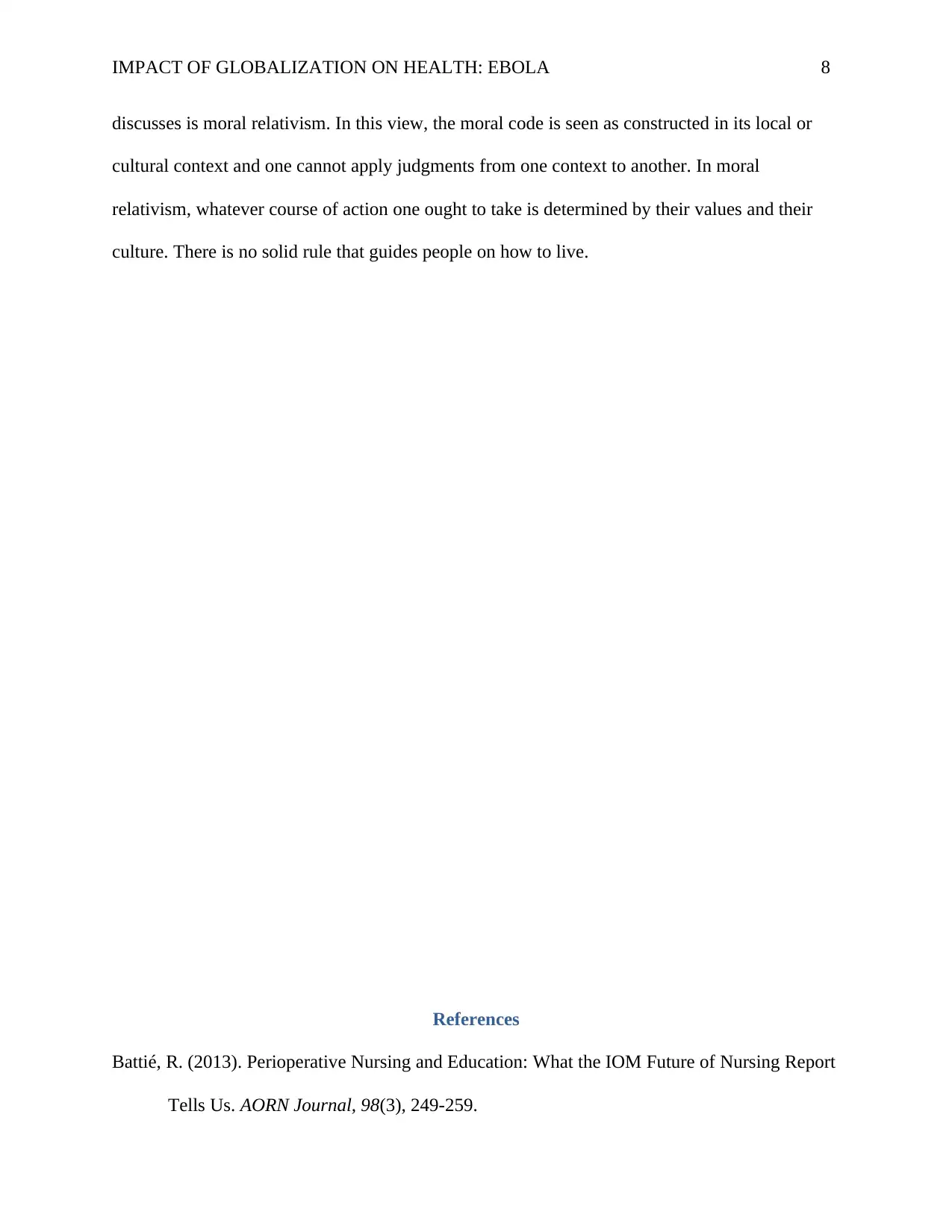
IMPACT OF GLOBALIZATION ON HEALTH: EBOLA 8
discusses is moral relativism. In this view, the moral code is seen as constructed in its local or
cultural context and one cannot apply judgments from one context to another. In moral
relativism, whatever course of action one ought to take is determined by their values and their
culture. There is no solid rule that guides people on how to live.
References
Battié, R. (2013). Perioperative Nursing and Education: What the IOM Future of Nursing Report
Tells Us. AORN Journal, 98(3), 249-259.
discusses is moral relativism. In this view, the moral code is seen as constructed in its local or
cultural context and one cannot apply judgments from one context to another. In moral
relativism, whatever course of action one ought to take is determined by their values and their
culture. There is no solid rule that guides people on how to live.
References
Battié, R. (2013). Perioperative Nursing and Education: What the IOM Future of Nursing Report
Tells Us. AORN Journal, 98(3), 249-259.
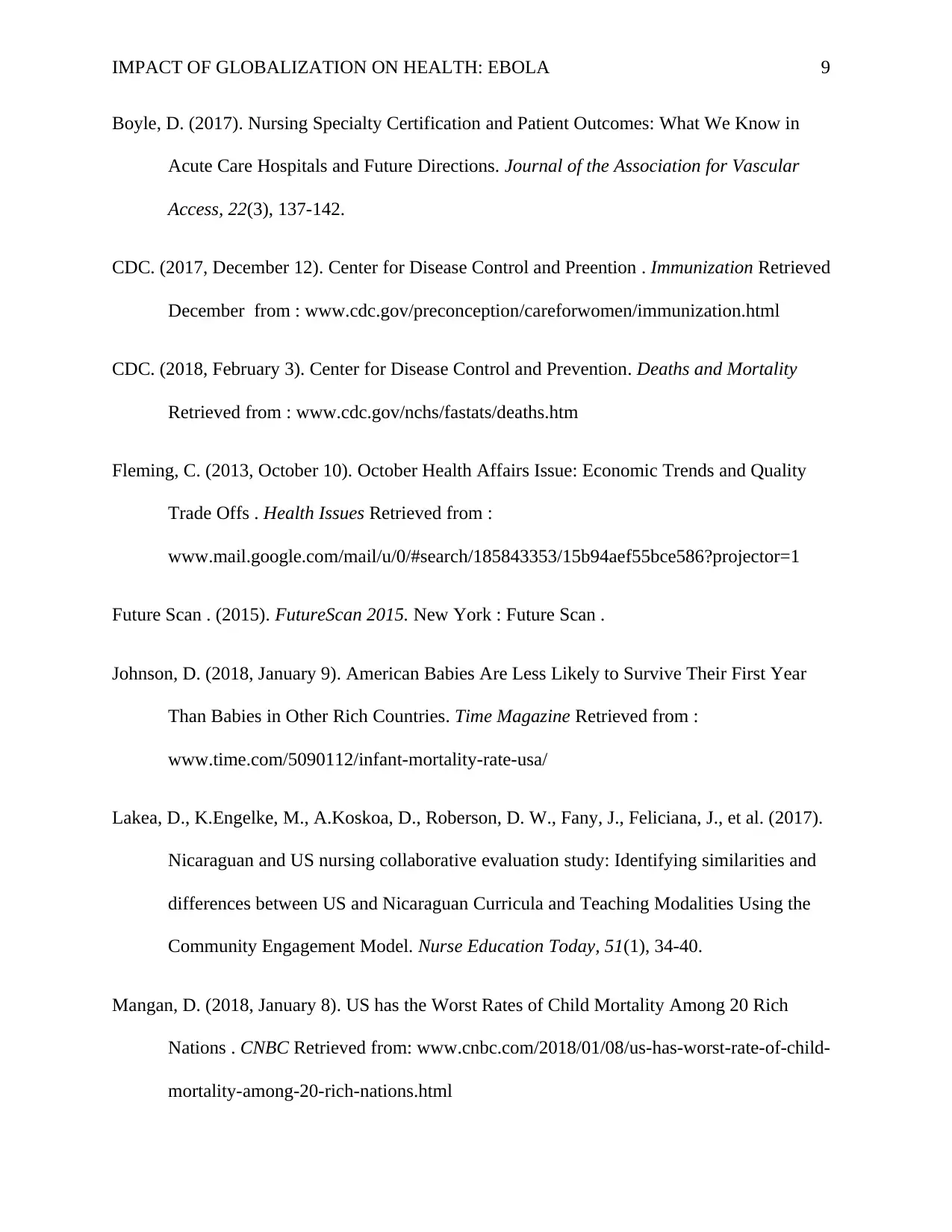
IMPACT OF GLOBALIZATION ON HEALTH: EBOLA 9
Boyle, D. (2017). Nursing Specialty Certification and Patient Outcomes: What We Know in
Acute Care Hospitals and Future Directions. Journal of the Association for Vascular
Access, 22(3), 137-142.
CDC. (2017, December 12). Center for Disease Control and Preention . Immunization Retrieved
December from : www.cdc.gov/preconception/careforwomen/immunization.html
CDC. (2018, February 3). Center for Disease Control and Prevention. Deaths and Mortality
Retrieved from : www.cdc.gov/nchs/fastats/deaths.htm
Fleming, C. (2013, October 10). October Health Affairs Issue: Economic Trends and Quality
Trade Offs . Health Issues Retrieved from :
www.mail.google.com/mail/u/0/#search/185843353/15b94aef55bce586?projector=1
Future Scan . (2015). FutureScan 2015. New York : Future Scan .
Johnson, D. (2018, January 9). American Babies Are Less Likely to Survive Their First Year
Than Babies in Other Rich Countries. Time Magazine Retrieved from :
www.time.com/5090112/infant-mortality-rate-usa/
Lakea, D., K.Engelke, M., A.Koskoa, D., Roberson, D. W., Fany, J., Feliciana, J., et al. (2017).
Nicaraguan and US nursing collaborative evaluation study: Identifying similarities and
differences between US and Nicaraguan Curricula and Teaching Modalities Using the
Community Engagement Model. Nurse Education Today, 51(1), 34-40.
Mangan, D. (2018, January 8). US has the Worst Rates of Child Mortality Among 20 Rich
Nations . CNBC Retrieved from: www.cnbc.com/2018/01/08/us-has-worst-rate-of-child-
mortality-among-20-rich-nations.html
Boyle, D. (2017). Nursing Specialty Certification and Patient Outcomes: What We Know in
Acute Care Hospitals and Future Directions. Journal of the Association for Vascular
Access, 22(3), 137-142.
CDC. (2017, December 12). Center for Disease Control and Preention . Immunization Retrieved
December from : www.cdc.gov/preconception/careforwomen/immunization.html
CDC. (2018, February 3). Center for Disease Control and Prevention. Deaths and Mortality
Retrieved from : www.cdc.gov/nchs/fastats/deaths.htm
Fleming, C. (2013, October 10). October Health Affairs Issue: Economic Trends and Quality
Trade Offs . Health Issues Retrieved from :
www.mail.google.com/mail/u/0/#search/185843353/15b94aef55bce586?projector=1
Future Scan . (2015). FutureScan 2015. New York : Future Scan .
Johnson, D. (2018, January 9). American Babies Are Less Likely to Survive Their First Year
Than Babies in Other Rich Countries. Time Magazine Retrieved from :
www.time.com/5090112/infant-mortality-rate-usa/
Lakea, D., K.Engelke, M., A.Koskoa, D., Roberson, D. W., Fany, J., Feliciana, J., et al. (2017).
Nicaraguan and US nursing collaborative evaluation study: Identifying similarities and
differences between US and Nicaraguan Curricula and Teaching Modalities Using the
Community Engagement Model. Nurse Education Today, 51(1), 34-40.
Mangan, D. (2018, January 8). US has the Worst Rates of Child Mortality Among 20 Rich
Nations . CNBC Retrieved from: www.cnbc.com/2018/01/08/us-has-worst-rate-of-child-
mortality-among-20-rich-nations.html
⊘ This is a preview!⊘
Do you want full access?
Subscribe today to unlock all pages.

Trusted by 1+ million students worldwide
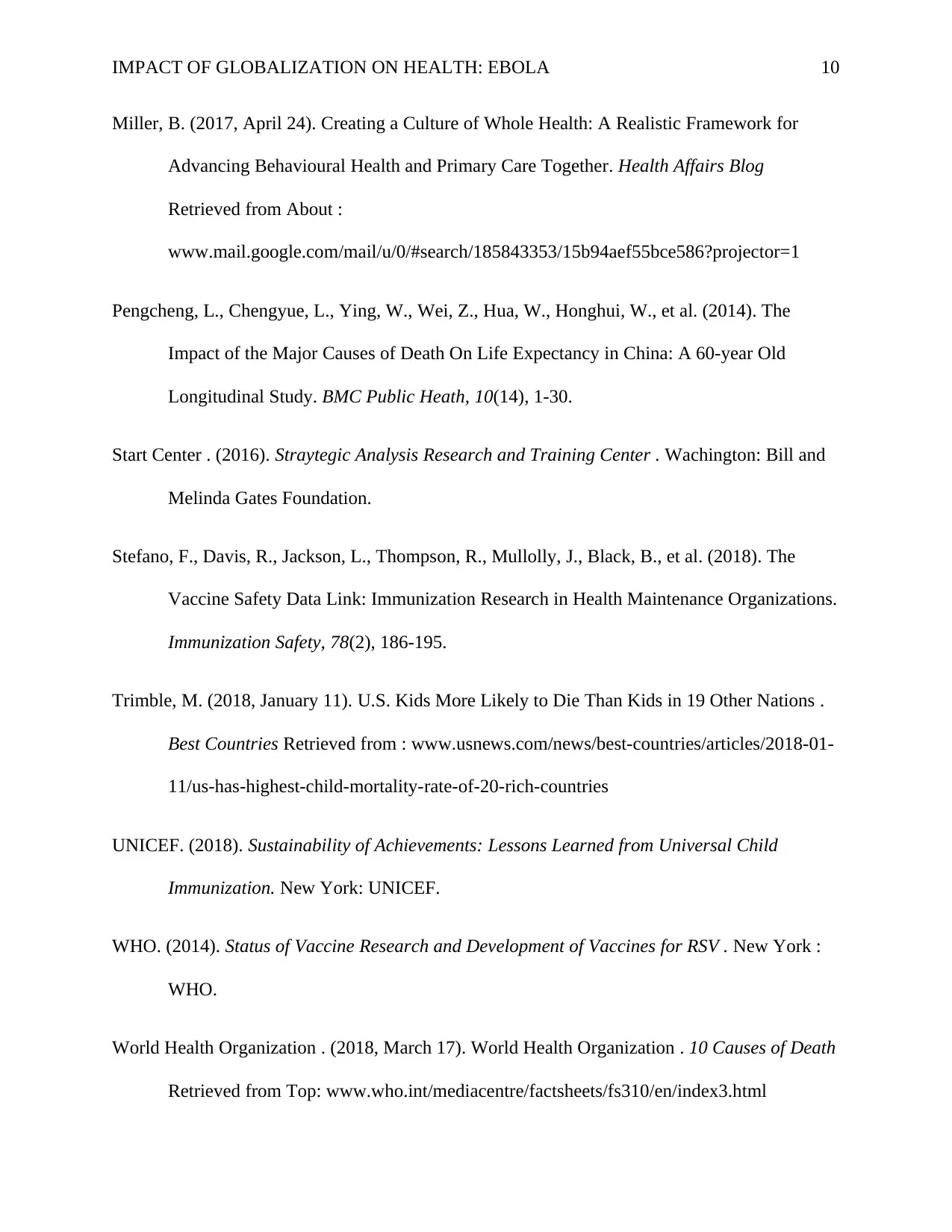
IMPACT OF GLOBALIZATION ON HEALTH: EBOLA 10
Miller, B. (2017, April 24). Creating a Culture of Whole Health: A Realistic Framework for
Advancing Behavioural Health and Primary Care Together. Health Affairs Blog
Retrieved from About :
www.mail.google.com/mail/u/0/#search/185843353/15b94aef55bce586?projector=1
Pengcheng, L., Chengyue, L., Ying, W., Wei, Z., Hua, W., Honghui, W., et al. (2014). The
Impact of the Major Causes of Death On Life Expectancy in China: A 60-year Old
Longitudinal Study. BMC Public Heath, 10(14), 1-30.
Start Center . (2016). Straytegic Analysis Research and Training Center . Wachington: Bill and
Melinda Gates Foundation.
Stefano, F., Davis, R., Jackson, L., Thompson, R., Mullolly, J., Black, B., et al. (2018). The
Vaccine Safety Data Link: Immunization Research in Health Maintenance Organizations.
Immunization Safety, 78(2), 186-195.
Trimble, M. (2018, January 11). U.S. Kids More Likely to Die Than Kids in 19 Other Nations .
Best Countries Retrieved from : www.usnews.com/news/best-countries/articles/2018-01-
11/us-has-highest-child-mortality-rate-of-20-rich-countries
UNICEF. (2018). Sustainability of Achievements: Lessons Learned from Universal Child
Immunization. New York: UNICEF.
WHO. (2014). Status of Vaccine Research and Development of Vaccines for RSV . New York :
WHO.
World Health Organization . (2018, March 17). World Health Organization . 10 Causes of Death
Retrieved from Top: www.who.int/mediacentre/factsheets/fs310/en/index3.html
Miller, B. (2017, April 24). Creating a Culture of Whole Health: A Realistic Framework for
Advancing Behavioural Health and Primary Care Together. Health Affairs Blog
Retrieved from About :
www.mail.google.com/mail/u/0/#search/185843353/15b94aef55bce586?projector=1
Pengcheng, L., Chengyue, L., Ying, W., Wei, Z., Hua, W., Honghui, W., et al. (2014). The
Impact of the Major Causes of Death On Life Expectancy in China: A 60-year Old
Longitudinal Study. BMC Public Heath, 10(14), 1-30.
Start Center . (2016). Straytegic Analysis Research and Training Center . Wachington: Bill and
Melinda Gates Foundation.
Stefano, F., Davis, R., Jackson, L., Thompson, R., Mullolly, J., Black, B., et al. (2018). The
Vaccine Safety Data Link: Immunization Research in Health Maintenance Organizations.
Immunization Safety, 78(2), 186-195.
Trimble, M. (2018, January 11). U.S. Kids More Likely to Die Than Kids in 19 Other Nations .
Best Countries Retrieved from : www.usnews.com/news/best-countries/articles/2018-01-
11/us-has-highest-child-mortality-rate-of-20-rich-countries
UNICEF. (2018). Sustainability of Achievements: Lessons Learned from Universal Child
Immunization. New York: UNICEF.
WHO. (2014). Status of Vaccine Research and Development of Vaccines for RSV . New York :
WHO.
World Health Organization . (2018, March 17). World Health Organization . 10 Causes of Death
Retrieved from Top: www.who.int/mediacentre/factsheets/fs310/en/index3.html
Paraphrase This Document
Need a fresh take? Get an instant paraphrase of this document with our AI Paraphraser
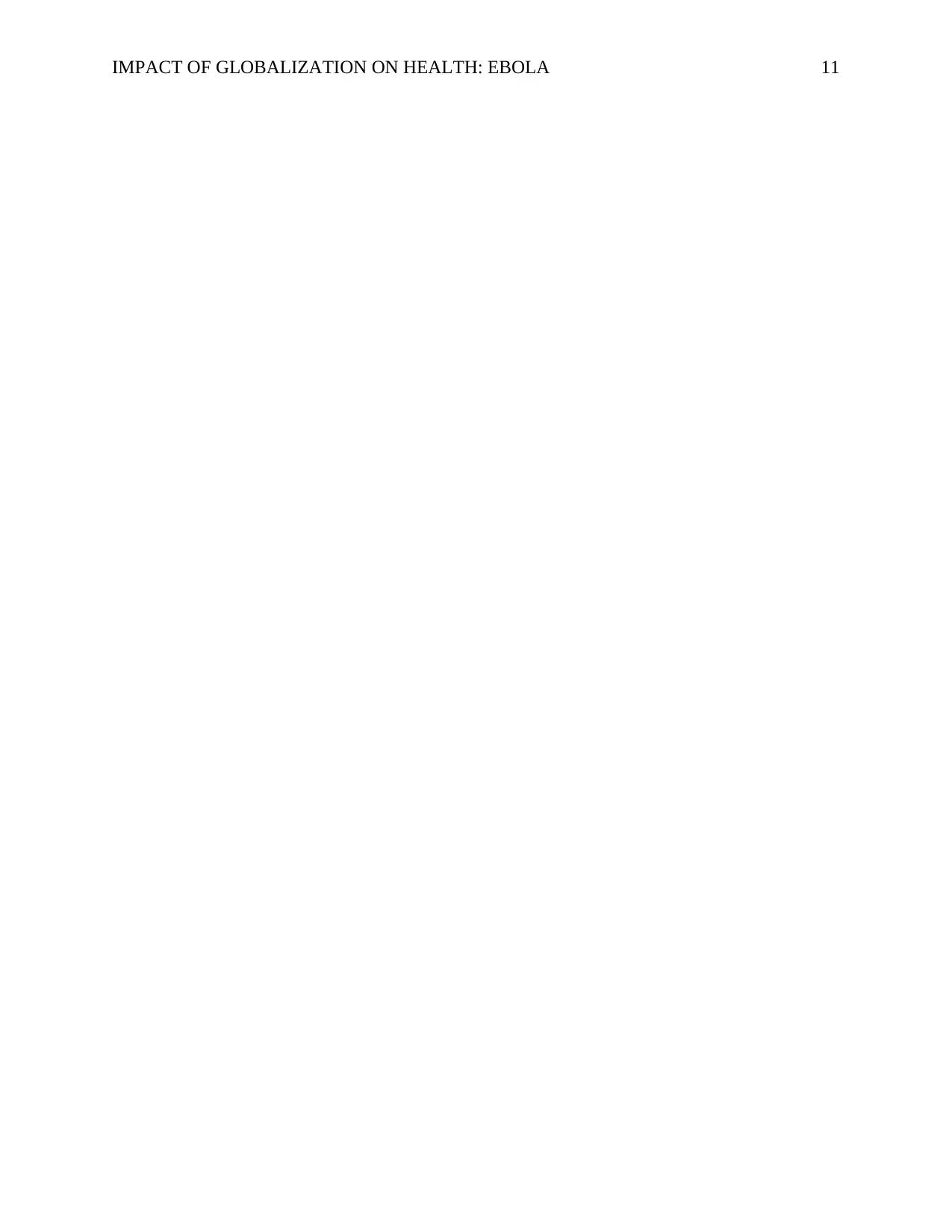
IMPACT OF GLOBALIZATION ON HEALTH: EBOLA 11
1 out of 11
Related Documents
Your All-in-One AI-Powered Toolkit for Academic Success.
+13062052269
info@desklib.com
Available 24*7 on WhatsApp / Email
![[object Object]](/_next/static/media/star-bottom.7253800d.svg)
Unlock your academic potential
Copyright © 2020–2025 A2Z Services. All Rights Reserved. Developed and managed by ZUCOL.





